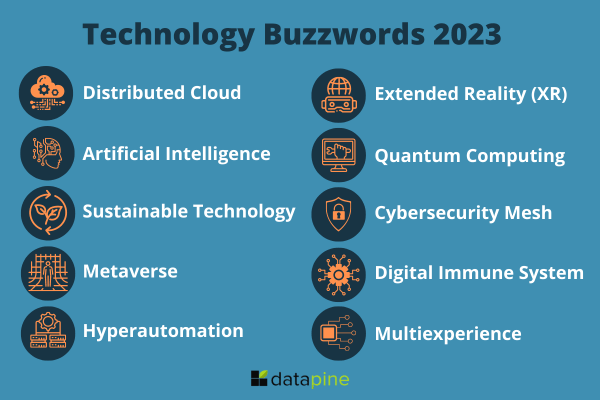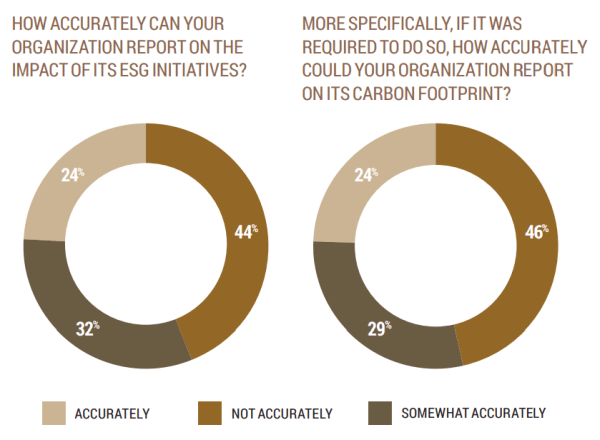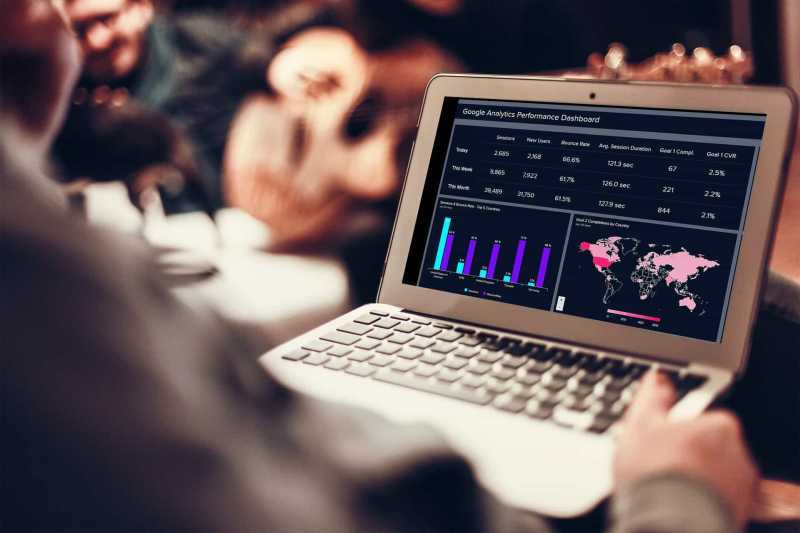10 IT & Technology Buzzwords You Won’t Be Able To Avoid In 2023

Business Intelligence Trends 2023
The digital world is in a constant state of evolution, with trends, technologies, and company cultures changing with the passing of every year.
If you don’t pay attention to the changes or keep up the pace, falling behind the times (and the market) is inevitable. And if that happens, your competitors are likely to leave you in the commercial dust.
The solution? Get to grips with the latest technology buzzwords and understand what they mean in a living, breathing business context.
While that may sound easier said than done, here, we’re going to explore the 10 definitive IT & technology buzzwords you won’t be able to avoid in 2023. These essential buzzwords will shape the professional landscape in 2023 and beyond, giving you a deeper insight into where to invest your efforts in the new year and beyond.
Without further ado, let’s start our journey of the new technology words for 2023.
1. Distributed Cloud
The first in our essential rundown of tech buzzwords for next year is distributed cloud. Exciting and futuristic, the concept of computer vision took the industry by storm last year. The concept is based on computing devices or programs gaining the ability to extract detailed information from visual images. And building on this most essential of 2023 tech buzzwords, the distributed cloud is here to take the concept of computer vision a step further. No matter if you need to conduct quick online data analysis or gather enormous volumes of data, this concept will make a significant impact in the future.
The distributed cloud offers businesses or organizations across industries the ability to store, access, and interact with acquired data using a more dynamic as well as a flexible range of options.
This new and evolved means of cloud computing can assist with the protection and management of computer vision data and intelligence and comes in many forms, including:
- Cloud BI: Advanced monitoring, reporting, and visualizing data through advanced cloud solutions and BI create sustainable business development.
- Internet of Things (IoT) edge cloud: Distributed services that connect and interact directly with edge services.
- 5G mobile edge cloud: The management and delivery of any cloud-based services linked to a 5G or mobile carrier service.
- On-premises public-style cloud: A branch of cloud distribution that stores, protects, and manages all of a business’s on-site or internal data.
- Metro-area computing cloud: Distributed cloud services that are segmented into nodes to serve an entire city or metropolitan area managing a range of services and residents.
- Global network edge-based cloud: A form of distributed cloud computing designed to interact and integrate with global network-based infrastructures such as routers, hubs, and mobile towers.
As you can see, the distributed cloud covers a range of innovations and concepts, giving it a variety of use cases and services. As such, it’s amongst the new technology buzzwords you can’t afford to ignore in 2023.
2. Artificial Intelligence (AI)
Already in our shortlist of last year, artificial intelligence is on the front scene for 2023. Scientists have been working on AI for years and in the coming years, we will see some more new applications.

AI refers to the autonomous intelligent behavior of software or machines that have a human-like ability to make decisions and to improve over time by learning from experience. Currently, popular approaches include statistical methods, computational intelligence, and traditional symbolic AI.
There are a large number of tools used in AI, including versions of search and mathematical optimization, logic, methods based on probability and economics, and many others. In business intelligence, we are evolving from static reports on what has already happened to proactive analytics with a live dashboard assisting businesses with more accurate reporting. They indeed enable you to see what is happening at every moment and send alerts when something is off-trend.
An important part of AI comprises machine learning, and more specifically deep learning – that trend promises more powerful and fast machine learning. An exemplary application of this trend would be Artificial Neural Networks (ANN) – the predictive analytics method of analyzing data. Neural networks create a system of interconnected layers with each subsequent layer acting as a filter for more and more complex features that combine those of the previous layer. This feature hierarchy and the filters that model significance in the data, make it possible for the layers to learn from experience. Thus, deep nets can crunch unstructured data that was previously not available for unsupervised analysis.
You can see an application in BI with the datapine solution, which comprises an AI algorithm based on the most advanced neural networks for its alerts. That way, any anomaly is identified with high accuracy, as it learns from historical trends and patterns: every unexpected event will be notified, and an alert sent.
Some more examples of AI applications can be found in various domains: in 2023 we will experience more AI in combination with big data in healthcare. Heart monitors, health monitors, and EEG signal processing algorithms are already on the research frontline. Likewise, major advances have been made in the field of self-driving cars, as major businesses, like Tesla and Volvo, are competing to take over the market. Volvo has announced that their autonomous car drivers will have the option to “eat, sleep, work, watch a movie, relax, do whatever.”
Another direction in which AI is heading is the introduction of a truly smart smartphone that would be able to make stuff for us. For example, you could tell your phone about the trip you plan and it would book the most convenient flight, hotel, and rental car for you. Likewise, last year was the year of digital assistants: Alexa, and Cortana, all of which have taken the consumer market by storm. It is not going to stop in 2023, as their development is never-ending; Google Now and Siri have become ubiquitous, thanks in large part to the voice recognition software becoming much more powerful over the past year.
Siri, Cortana, and Alexa all share similar roles – enabling us to live a step closer to the futuristic notions of having AI assistants that can do anything we need on a whim. Who knows, maybe AI will even have the potential to make or at least help us with our strategic business decisions in the near future.
Another key AI development to watch out for in 2023 is generative artificial intelligence (GAN). Generative AI leverages machine learning capabilities to uncover fresh insights about specific pieces of content or digital objects without humans having to program or teach the model. These incredible new branches of AI can write or develop code, target marketing opportunities, and identify new product opportunities free from human intervention.
GAN is set to open the AI landscape even more in the next year. An increasing number of organizations will leverage generative AI to create more immersive content and multimedia marketing experiences while making vital improvements to the healthcare industry by empowering medical professionals to access comprehensive 3D X-rays of patient bone issues or tumors, for example.
Now, while all these AI-driven applications are making people's and companies' lives easier, there is still a concern about the impact of AI technologies, especially when it comes to security. In that sense, a new framework aims at ensuring AI Trust, Risk, and Security Management to mitigate these risks and comply with new regulations about the use of AI systems. Also known as AI TRiSM, it is a set of capabilities and technologies that businesses from all industries are adopting to ensure AI models governance, trustworthiness, security, and privacy for both enterprises and end-users.
The need for AI TRiSM is born out of the growing range of AI models and systems that businesses are offering customers today. In many cases, these systems are so complex that not even the experts can understand them, leaving a big gap for security issues in the future. These issues can translate into privacy failures that can harm users as well as big financial and reputational losses for the organization, making the adoption of AI TRiSM processes even more relevant. In fact, Gartner states that, by 2026, organizations who adopt these practices will see their AI models achieve a 50% result improvement in terms of adoption, company goals, and user acceptance.
The future growth of AI is undeniable. The research firm Markets and Markets, for instance, estimates that the AI market will grow from $16.06 billion in 2017 to $190.61 billion by 2025.
AI is undoubtedly among the most prominent trends in technology to look out for. Gartner has stated that “AI in the form of automated things and augmented intelligence is being used together with IoT, edge computing, and digital twins.” We will probably talk about AI as the megatrend of the future.
3. Sustainable Technology
Sustainable technology is expected to be one of the top technology trends in business for the coming year. As a key part of Gartner’s 2023 tech trends report, this concept is defined as a “framework of digital solutions that can enable environmental, social and governance (ESG) outcomes for the enterprise and its customers”. It can impact businesses in three key areas: internal IT, and enterprise and customer operations. Internal IT means working with the right tools to deliver the best ESG outcomes. Enterprise operations refer to transparency regarding environmental impact and the optimization of energy and material usage. And customer operations refers to delivering products and services to help customers meet their own sustainability goals.
It cannot be denied that for a couple of years, many businesses have begun to take responsibility for their environmental impact due to social pressures regarding global warming and environmental care, especially by millennials who are expected to become the biggest investors of these initiatives in the future. That said, the voluntary interest will become mandatory within the next year as financial regulators in the UK, EU, US, Canada, and others will mandate public companies to report on their carbon emissions. For this purpose, organizations will turn to ESG metrics and reporting to stay compliant with the new regulations. But, this will not come without challenges.
According to Info-Tech latest technology trends report, IT professionals are committed to tracking ESG initiatives and metrics but are not confident about how to do so. A high 43% of respondents say that their ESG reporting is not accurate, while 46% say their carbon footprint reporting is even less accurate (see graph below).

**Resource: Info-Tech Technology Trends Report 2023**
In that sense, it is important for high-level executives to take charge and ensure the right tools and processes are implemented to develop a correct ESG reporting environment. Info-Tech advises implementing an ESG budget for 2023, assessing employees' capabilities of adapting to new reporting requirements, finding data gaps, and investing in the right tools to ensure alignment with the new ESG mandates as a great starting point for businesses.
Sustainable Technology is one of the IT trends that are here to stay and it is gaining traction across the world. The international Sustainability Standard Board (ISSB) already published two drafts in March 2022 that will serve as guidelines for regulators in different countries to model their new regulations after. In the US, by 2023, companies with more than $700 million in the hands of public investors are expected to collect data and report on their climate impact by 2024. Smaller companies with public investment are expected to file in 2025 and 2026 depending on the size. In the EU, a Corporate Sustainability Reporting Directive has been adopted since October 2022, and companies are expected to start reporting under it starting in 2024. Smaller enterprises have until 2026 to comply with the new requirements.
Definitely, one of the most important emerging technology trends to look out for in 2023.
4. Metaverse
If you have been on the internet or social media at all during 2022, then you probably heard about our coming buzzword. Initially coined as a sci-fi concept by writer Neal Stephenson in the early 1990s, the metaverse combines multiple technologies to create a digital world, parallel to the physical world, in which social and economic activities are carried out. Users can interact with these digital ecosystems thanks to virtual and augmented reality technologies in different formats. On one hand, VR tools such as headsets, gloves, and even full-body tracking suits enable users to interact and fully immerse themselves in this virtual reality. And, on the other hand, AR is a bit less immersive as it combines the real-world and digital worlds in one experience.
While corporations like Roblox have been using virtual experience in video games for a few years now, the metaverse gained popularity after Mark Zuckerberg, founder of Facebook, started talking about it in 2021. Year in which the company was rebranded as “Meta” with an announcement of a $10 billion investment into the concept. From there, multiple businesses from a range of industries including fashion, music, video, and even real estate started jumping into it offering different products, services, and experiences inside this digital ecosystem. With over 160 companies working on metaverse projects to date, according to research.
All things considered, it is not surprising that the metaverse industry is expected to grow to $1,607.12 billion in 2030. With social media and gaming companies setting themselves as pioneers in the field. Some of the biggest players in the industry today include Meta (Facebook), NVIDIA, Microsoft, Apple, Google, Roblox, NetEase, and Epic Games, among others.
For 2023, the metaverse is expected to permeate even more industries including the business world, where initiatives such as virtual workspaces might come as a solution for hybrid work where employees can connect and collaborate in a digital environment. Another way in which the metaverse is expected to gain popularity in the coming year is through NFTs.
Non-fungible tokens (NFTs) are digital assets based on the same blockchain tech used by cryptocurrency. However, instead of money, an NFT can be anything from a piece of art, digital real estate, or a pair of sneakers. An NFT provides proof of ownership so the asset can be sold in the metaverse, with many big corporations already investing in it. For instance, Nike and Roblox collaborated to create “Nikeland” a virtual space in which users can play games and dress their avatars in virtual clothes. Other brands that are leading the way with NFTs include Coca-Cola, Gucci, Budweiser, Adidas, and Samsung, among various others.
As exciting as it sounds, the metaverse is still a new concept, and its implications in terms of long-term investment and security are still not clear. Gartner advises businesses to carefully assess and identify metaverse-inspired initiatives based on successful use cases across industries. Paired with that, establishing clear governance, security, and privacy policies beforehand will also serve as a security blanket for organizations wanting to jump into this trend that will rule the market in 2023.
Try our analytics software 14-days for free & see these words in action!
5. Hyperautomation
AI was certainly a prominent buzzword last year, and as mentioned, its evolution still makes it a vital term in 2023. Catalytic evolutions in the autonomous tech world have now given birth to one of the most disruptive tech buzzwords for 2023- hyperautomation.
Hyperautomation is an innovation that results in the creation of a ‘digital twin’: a self-sufficient bot that can conduct a range of sophisticated human tasks, often under pressured environments.
In our hyper-connected digital age, ‘automation’ is one of the most prominent IT buzzwords or concepts you’re likely to hear as it covers such a broad spectrum of developments. But hyperautomation is an innovation in its infancy, and it’s expected to explode in 2023.
Hyperautomation is based on the application of advanced technologies, including AI and ML (machine learning), with the aim of automating a host of people-centric processes while augmenting human roles within organizations across industries. Hyperautomation covers a broad range of tools, including a dashboard tool, but also refers to the sophistication of the automation itself.
While many are fearful of hyperautomation, rather than replacing people, the invention of digital twins will allow organizations to visualize and improve existing processes while helping people drive their roles to exciting new heights with the assistance of advanced automation.
Hyperautomation doesn’t exist to replace humans - it’s actually an incredibly sophisticated form of business intelligence (BI) for the new age.
6. Extended Reality (XR)
Next on our big rundown of IT buzzwords is extended reality (XR). The likes of augmented reality (AR) and virtual reality (VR) have made significant waves in the past five years, changing the way we live both personally and professionally. Now, it’s time to embrace a whole new virtual realm.
XR is one of the most impactful computer science buzzwords you’ll encounter in 2023. Its practical potential is enormous, particularly when you consider our current global situation. COVID-19 has placed us in a state of mass isolation, accelerating the value of remote communication and virtual experiences.
XR utilizes the best elements of AR and VR, using headsets and specialist tools or equipment to simulate face-to-face interaction for indefinite periods of time. The other reason that XR is so powerful is that it will empower people to conduct experiments, provide services, and perform testing in a safe, secure environment from anywhere on the planet.

One of the use cases of XR comes in the form of eye tests. Using XR innovations, opticians can conduct eye tests virtually, with high-definition cameras offering a clearly defined image of the patient's eye. This is an AR tool that empowers the patient to browse the selection of glasses based on their preferences and try them on virtually without having to leave their home.
XR is one of those information technology buzzwords that will remain at the forefront of our collective consciousness for some time. In 2023, cosmetics and health brands will embrace the power of augmented reality filters to empower consumers to get up close and personal with their products from anywhere in the world. Real estate companies will utilize XR applications to add an extra layer of realism and texture to virtual property viewings. Furniture, tech, and toy companies will use XR applications to develop user instruction manuals that offer dynamic, realistic visuals and information to make product examination easier as well as more immersive.
As XR continues to evolve and gain momentum, its capabilities will become all the more limitless, creating sophisticated virtual environments that solve complex problems and serve an endless range of human needs on a grand scale. It’s a buzzword in IT to keep a keen eye on.
“AI and XR are not a Man versus Machine saga; they’re in fact, Man with Machine synergy.” – Sudipto Ghos
7. Quantum Computing
Quantum computing will continue to be a major technology buzzword in 2023. In general, quantum computers can solve much more complex problems than classical electronic computers by using quantum bits (qubits) instead of binary digits (bits). This means that the data doesn’t have to be limited to two defined states anymore: 0 or 1. For this reason, quantum computing is much more flexible by allowing computations to be performed in parallel.
However, the real challenge is how quantum machines really carry out these quantum computations. Scientists have been researching this field for decades, so it may still take some years before quantum computing becomes a reality. Nevertheless, the increasing potential to use quantum computing has even made Google map the path to quantum supremacy. There are many ways in which this new way of computing can be utilized, from cryptography (the most common area people associate with quantum computing), forecasting, and aviation, but the interesting part lies within data analysis and interpretation. Although quite far from the everyday usage of quantum systems, big organizations like NASA are already looking into utilizing it for analyzing the enormous data they collect about the universe.
“Threat is a mirror of security gaps. Cyber-threat is mainly a reflection of our weaknesses. An accurate vision of digital and behavioral gaps is crucial for a consistent cyber-resilience.”― Stephane Nappo
8. Cybersecurity Mesh
The next of our essential IT industry buzzwords is cybersecurity mesh. In our increasingly hyper-connected digital world, sensitive data lives in many spaces and places. Cybercrime is a constant threat, and as such, businesses across industries will be ramping up their cybersecurity efforts in 2023.
Cyber attacks collectively cost an average of $2.9 million a minute to resolve, with a price tag of around $25 per minute to tackle organizational breaches. That’s a colossal dent in any business budget - the kind that can damage not just your financial health but also your brand reputation.
To tackle cybercrime head-on and reduce data vulnerabilities, forward-thinking company leaders will be rolling out robust cybersecurity mesh (CSMA) infrastructures to secure their stored data in every possible location.
Cybersecurity mesh empowers the world's most innovative stand-alone security solutions to work in unison to enhance overall security while shifting control points closer to the assets they are designed to secure. CSMA infrastructures exist to unify fragmented data security processes and work swiftly, as well as reliably, to discover, identify, verify, and resolve any information sensitivity issues across both cloud-based and non-cloud-based environments.
In addition to protecting every type of core or internal infrastructure, CSMA initiatives will also protect remote working networks where the threat of data breaches exists. As more people are working from home than ever before, cybersecurity meshing is the way forward in the universal protection of company information and assets.
By 2024, businesses adopting a cybersecurity mesh architecture will drive down the financial impact of security incidents by up to 90%. Considering cybercrime can derail entire organizations within a matter of hours, cybersecurity mesh is one of the most important phrases on our tech buzzwords list.
As a part of the constant effort to ensure a secure environment, for 2023 businesses are expected to start mixing their cybersecurity mesh efforts with the Zero Trust framework. Initially coined by John Kindervag at Forrester Research, this approach aims to protect company data by implementing a zero-trust policy for all users until proven otherwise. This means, regardless of the location, device, or identity of the user, every access to the company system needs to be verified. This way, the data can be protected and every interaction can be monitored to identify any potential threats.
In order to achieve a successful Zero Trust architecture, companies must align their security efforts with business outcomes, define governance processes for data access, and understand how the system and interactions work, among other things. All things considered, security will remain both a priority and a challenge for organizations as more technologies arise. Definitely, a trend to watch for 2023.
9. Digital Immune System
Next, in our list of the top technology trends for 2023, we have another concept presented by Gartner in their latest tech report: the digital immune system (DIS). This software design concept combines a set of practices and technologies including augmented testing, chaos engineering, autoremediation, and more, to increase the resilience of products, services, and systems and ensure excellent user experience (UX) while mitigating business risks.
With the digital landscape becoming more and more competitive by the day, organizations need to quickly adapt to market changes while providing customers with the best experience possible without any bugs or security issues. With that in mind, the DIS framework is expected to gain traction in 2023 as a great way to ensure healthy systems that translate into better UX as well as business performance. It does this by mitigating potential risks and looking at past failures as learning opportunities. In fact, Gartner expects that by 2025 organizations that invest in DIS will increase customer satisfaction by decreasing their downtime by 80%.
For 2023, companies that want to implement a DIS framework into their strategies must carefully assess which areas of the organization can benefit the most from it while still involving the entire organization in the process. Collaboration between development, security, and operations teams is key to ensuring positive adoption. Amongst the technologies and best practices needed to achieve successful digital immunity, Gartner advises businesses to take into account six key elements which include:
- Observability
- AI-augmented testing
- Chaos engineering
- Autoremediation
- Site reliability engineering (SRE)
- Software supply chain security
With user experience at the front, this technology buzzword will rule the software design landscape in 2023!
10. Multiexperience
Arguably one of the most potent technology buzzwords on the list, multiexperience is a concept that has the potential to accelerate the success of countless businesses as long as they’re willing to embrace its capabilities. Multiexperience made waves in 2022, and in 2023, it’s going to change the digital landscape in a big way.
Multiexperience explained
So, what is this most intriguing of tech buzzwords? The term multiexperience refers to the replacement of technologically advanced people with people-literate platforms or technologies. The evolution of a digital data dashboard, for instance, means that everyone within an organization can take charge of the insights that will not only empower them to do their job better but also drive the organization forward as a whole.

The idea of multiexperience is that it empowers everyone to perform to their optimum capabilities, improving engagement, and cementing interdepartmental communications in the process. Everyone gains access to invaluable information in a way that suits their strengths or capabilities, resulting in commercial growth and advanced self-service business intelligence across the board.
With multiexperience, the traditional notion of a computer or platform evolves from a single point of interaction to include multisensory and multi-touchpoint interfaces such as wearables, advanced computer sensors, or cloud-based tools that people can access remotely from a range of mobile devices.
As multiexperience evolves into 2023, experts predict that it will become more immersive, with virtual reality (VR), augmented reality (AR), and autonomous technologies at its heart. While multiexperience is a relatively new idea, it’s a concept that is growing at an incredible rate - and one of the IT trends of 2023 that commands attention.
Total experience explained
One of the IT buzzwords and acronyms directly related to multiexperience, total experience - or TX - is a brand-focused concept based on merging customer experience (CX), employee experience, and end-user experience to meet the exact needs of every key individual within an organization (internal and external).
TX is essentially a strategic approach to multiexperience innovations and investments that uses these tools or platforms to create links between employee performance and satisfaction and customer experience and satisfaction.
By creating a semi-autonomous landscape where the goals and needs of staff and consumers are integrated, companies can develop brand experiences that offer maximum value across every channel, improving customer loyalty, retention, and brand advocacy in the process. This is one to watch out for in 2023.
The more touch points you have at your disposal, the more rich data you’ll be able to collect - and by making these insights accessible throughout your organization through dynamic data discovery tools, great things will happen.
Try our analytics software 14-days for free & see these words in action!
So, What Are the Essential Technology Buzzwords & Trends for 2023?
2023 has a host of exciting tech innovations in store, many of which are yet to reveal their full potential. To keep your finger on the pulse, these top ten IT and tech buzzwords should take up the majority of your focus as a new year beckons. If you want to keep expanding your tech knowledge check out this insightful post about the best online learning platforms out there.
To keep your mind fresh, here is a summary of the top 10 technology buzzwords and trends for the coming year:
- Distributed Cloud
- Artificial Intelligence (AI)
- Sustainable Technology
- Metaverse
- Hyperautomation
- Extended Reality (XR)
- Quantum Computing
- Cybersecurity Mesh
- Digital Immune System
- Multiexperience
By embracing these powerful tech buzzwords of 2023 and using them to your advantage, you will accelerate the growth of your business in a landscape that is ever-changing.
Keeping on top of the ‘technology buzz’ is one of the cornerstones of success in our hyper-connected age. These buzzwords are not only inspiring, but they also offer a clear-cut insight into how companies as well as consumers are likely to interact with the world around them in 2023 and beyond.
Explore these essential software buzzwords, and you will uncover new market opportunities, which, in turn, will push you ahead of the pack and help you stay there, one initiative at a time. We hope that by understanding these ten tech buzzwords in 2023, you can hit the ground running as a new year dawns.
Use the buzzwords in technology (plus the right tools) as your guide, and you will grow your company in ways you never thought were imaginable.
Now is your time to shine. Get ahead of your competitors and try datapine for a 14-day trial completely free and benefit from the business-boosting power of data dashboards and software.